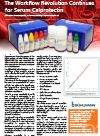Serum Calprotectin Open Access Assay for Clinical Chemistry Analysers
BÜHLMANN sCAL® turbo
The BÜHLMANN sCAL® turbo test is a particle enhanced turbidimetric immunoassay (PETIA) and allows quantification of calprotectin in human serum samples on clinical chemistry analysers.
BÜHLMANN sCAL® turbo
The BÜHLMANN sCAL® turbo is an in vitro diagnostic test designed for the quantitative determination of circulating calprotectin.
It is specific for the tetrameric format of calprotectin (MRP8/14) in human serum samples.
This avoids the background calprotectin that will be found in standard blood samples and is the dominant format found in serum due to the high and even distribution of calcium.

Samples can be measured without any additional dilution steps and are incubated with reaction buffer and mixed with polystyrene nanoparticles coated with calprotectin-specific antibodies (immunoparticles).
Any calprotectin available in the sample mediates immunoparticle agglutination and sample turbidity which is measured by light absorbance. The detected light absorbance allows quantification of calprotectin concentration via interpolation on an established calibration curve.
Assay Details
Sample volume: ~2-3µl
Time to first result: 10 minutes
Assay Range: 0.23 - 15µg/ml but can dilute 1:15 to cover 15 - 225µg/ml
Number of tests: Approximately 100 (dependent on the platform used)
All reagents are ready to use and have an on-board stability of 55 days
Calibration is stable for at least 30 days, but is analyser dependant
Accuracy/Recovery: 92 - 112.8%
Limit of Detection: 0.11µg/ml
Limit of Quantification: 0.23µg/ml
Assay Standardisation
The BÜHLMANN sCAL® turbo is standardized against internal reference material (purified native calprotectin).
Calibrator and control values are assigned according to a value transfer protocol (ref. 1, 2), to guarantee metrological traceability.
The analytical measuring interval of the BÜHLMANN sCAL® turbo, established on the Mindray BS-480 instrument, is 0.23-15.0 μg/mL.
Sample Collection
Blood can be collected into a serum tube or a gel separator tube, once clotted the tubes are centrifuged at 1800g for 15 minutes and then the serum is transferred into a plain tube.
This then prevents the contamination of the sample with un-released calprotectin which would cause higher values.
Once separated the samples can be stored at 2-8C for 16 days or for 1 month at -20C.
The reference intervals between serum and gel separator tubes is slightly different:
Reference Interval
The reference interval of the BÜHLMANN sCAL® turbo assay was established according to CLSI C28-A3 with 160 serum samples from self-declared healthy individuals: adult men and women aged 18 to 83 years.
The samples were collected either in native tube or tube with gel separator and processed within 3-4 hours after collection.
| Matrix | N | 95% Reference Limit* [µg/mL] | 2.5-97.5 Percentile [µg/mL] | 90% Confidence Interval Lower Reference Limit | 90% Confidence Interval Upper Reference Limit | ||||||
|---|---|---|---|---|---|---|---|---|---|---|---|
| Matrix | N | 95% Reference Limit* [µg/mL] | 2.5-97.5 Percentile [µg/mL] | 90% Confidence Interval Lower Reference Limit | 90% Confidence Interval Upper Reference Limit | Serum (native tube) | 160 | 1.77 | 0.24-2.01 | 0.11-0.31 | 1.78-2.74 |
| Matrix | N | 95% Reference Limit* [µg/mL] | 2.5-97.5 Percentile [µg/mL] | 90% Confidence Interval Lower Reference Limit | 90% Confidence Interval Upper Reference Limit | Serum (gel separator) | 160 | 1.10 | 0.19-1.80 | 0.06-0.23 | 1.10-2.07 |
BÜHLMANN sCAL turbo Reference Interval, * one-sided | |||||||||||
Comparison of the BÜHLMANN sCAL ELISA to the sCAL turbo
Because the assays are manufactured by the same company they have a good correlation, however, they are based on different standardisations and so will give significantly different results. The sCAL ELISA is based on the historic use of the dimeric format which will include the background level found normally within blood. The sCAL turbo is based on the tetrameric format which avoids the background level and so lower values will be obtained.


